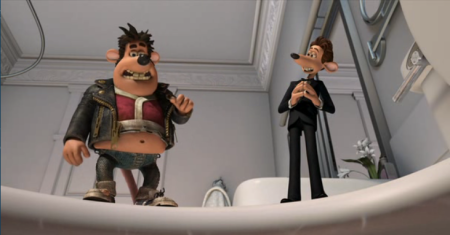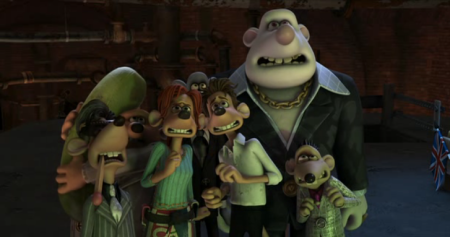 I really want to like this movie, since there’s so much neat stuff about it, both in concept and part of its execution. But something’s keeping me from being anything but apathetic towards it; like its positive and negative qualities perfectly cancel each other out leaving me with nothing. Man, that sounded kind of harsh. Anyway, the film is a loving homage to the B-horror movies of the 1950s, featuring an epic fight between monsters and aliens… kind of. Gallaxhar, an alien from a far-off world comes to Earth in search of a powerful element known as Quantonium, which via a meteorite caused bride-to-be Susan Murphy grow to be multiple stories tall. She’s apprehended by the government and put up in asylum with a gaggle of other oddballs: the genius insect-headed Dr. Cockroach, the human-fish hybrid Missing Link, the mindless (literally) blob B.O.B., and the gargantuan bug Insectasaurus. When Gallaxhar sends a giant robot to San Francisco to scope out his element, the government has no option but to send the monsters to fight it, allowing their freedom if they succeed.
I really want to like this movie, since there’s so much neat stuff about it, both in concept and part of its execution. But something’s keeping me from being anything but apathetic towards it; like its positive and negative qualities perfectly cancel each other out leaving me with nothing. Man, that sounded kind of harsh. Anyway, the film is a loving homage to the B-horror movies of the 1950s, featuring an epic fight between monsters and aliens… kind of. Gallaxhar, an alien from a far-off world comes to Earth in search of a powerful element known as Quantonium, which via a meteorite caused bride-to-be Susan Murphy grow to be multiple stories tall. She’s apprehended by the government and put up in asylum with a gaggle of other oddballs: the genius insect-headed Dr. Cockroach, the human-fish hybrid Missing Link, the mindless (literally) blob B.O.B., and the gargantuan bug Insectasaurus. When Gallaxhar sends a giant robot to San Francisco to scope out his element, the government has no option but to send the monsters to fight it, allowing their freedom if they succeed. So while this movie pays tribute and inspiration from 1950s sci-fi films, ultimately it’s a story about a woman who learns to do things for herself. And that’s kind of trite and overdone. But that on its own doesn’t make it bad. Kung Fu Panda is your typical hero’s journey/schmucky underdog tale, but it triumphs based upon the characters and how it’s told. As a lead, Susan isn’t all that captivating. She’s cute and we root for her, sure, but there’s not really much to her character that makes her truly engaging. Her plight is also rather dry; her fiance only cares about his career! Was this ripped from a C-grade romantic comedy? Through the movie, she learns to take matters into her own hands, crowing about what she’s done without her man, like stop a giant alien robot! All on her own… with the assistance of super powers. But in the end, she manages to kick ass when she’s back to normal again, so that transformation comes out mostly satisfying in the end.
So while this movie pays tribute and inspiration from 1950s sci-fi films, ultimately it’s a story about a woman who learns to do things for herself. And that’s kind of trite and overdone. But that on its own doesn’t make it bad. Kung Fu Panda is your typical hero’s journey/schmucky underdog tale, but it triumphs based upon the characters and how it’s told. As a lead, Susan isn’t all that captivating. She’s cute and we root for her, sure, but there’s not really much to her character that makes her truly engaging. Her plight is also rather dry; her fiance only cares about his career! Was this ripped from a C-grade romantic comedy? Through the movie, she learns to take matters into her own hands, crowing about what she’s done without her man, like stop a giant alien robot! All on her own… with the assistance of super powers. But in the end, she manages to kick ass when she’s back to normal again, so that transformation comes out mostly satisfying in the end. The movie really shines with its monsters, not surprising given the title, all of whom are a lot of fun to watch. Will Arnett’s Missing Link is like a wannabe womanizer, as if the Creature from the Black Lagoon only came to shore to hit on chicks rather than terrorize. Hugh Laurie’s Dr. Cockroach is your typical mad scientist, but also a refined gentleman, with a few flourishes in attempting to sound hip (“We all think the new Susan is the cat’s me-wow! Heh heh… I’m sorry.”) Seth Rogan’s B.O.B. is basically Seth Rogan in blob form, but his voice and his laugh perfectly fit that character. Insectasaurus is great for what we see of it, as well as its big twist at the end, and also sweet is his kinship with Link, giving him a sweeter edge apart from his would-be macho persona. Also fantastic are Kiefer Sutherland as General W.R. Monger (great pun), no-nonsense military type who actually is nicer than he lets on, and the greatest casting of all, Stephen Colbert as the President, who’s basically playing… Stephen Colbert. Rainn Wilson as Gallaxhar is alright too, I guess. He’s not bad, but something about the performance didn’t work for me. Maybe I just couldn’t get Dwight out of my head.
The movie really shines with its monsters, not surprising given the title, all of whom are a lot of fun to watch. Will Arnett’s Missing Link is like a wannabe womanizer, as if the Creature from the Black Lagoon only came to shore to hit on chicks rather than terrorize. Hugh Laurie’s Dr. Cockroach is your typical mad scientist, but also a refined gentleman, with a few flourishes in attempting to sound hip (“We all think the new Susan is the cat’s me-wow! Heh heh… I’m sorry.”) Seth Rogan’s B.O.B. is basically Seth Rogan in blob form, but his voice and his laugh perfectly fit that character. Insectasaurus is great for what we see of it, as well as its big twist at the end, and also sweet is his kinship with Link, giving him a sweeter edge apart from his would-be macho persona. Also fantastic are Kiefer Sutherland as General W.R. Monger (great pun), no-nonsense military type who actually is nicer than he lets on, and the greatest casting of all, Stephen Colbert as the President, who’s basically playing… Stephen Colbert. Rainn Wilson as Gallaxhar is alright too, I guess. He’s not bad, but something about the performance didn’t work for me. Maybe I just couldn’t get Dwight out of my head. There’s a lot of really neat sequences and moments, the most show-stopping being the fight with the robot on the Golden Gate Bridge, which is just spectacular. Though that almost works to the film’s detriment as the final fight on the mother ship doesn’t quite live up to it. I think an issue is that they made Gallaxhar too goofy; he’s kind of overly comical and the monsters infiltrate the ship and get to the main core almost too easily. It’s all played for laughs of course, but as high as the tension was supposed to be, I never felt any real danger in the climax. Granted the whole movie is basically screwball, but they toyed with having some more emotional scenes and succeeded, like when the monsters were at their lowest point. Also featured are a fair amount of groaner pop culture gags, like Link referencing An Inconvenient Truth and the main core being like a DDR machine. But largely the humor comes from the characters, be it the monsters trying to occupy their time in lock down or working together to stop an alien invasion.
There’s a lot of really neat sequences and moments, the most show-stopping being the fight with the robot on the Golden Gate Bridge, which is just spectacular. Though that almost works to the film’s detriment as the final fight on the mother ship doesn’t quite live up to it. I think an issue is that they made Gallaxhar too goofy; he’s kind of overly comical and the monsters infiltrate the ship and get to the main core almost too easily. It’s all played for laughs of course, but as high as the tension was supposed to be, I never felt any real danger in the climax. Granted the whole movie is basically screwball, but they toyed with having some more emotional scenes and succeeded, like when the monsters were at their lowest point. Also featured are a fair amount of groaner pop culture gags, like Link referencing An Inconvenient Truth and the main core being like a DDR machine. But largely the humor comes from the characters, be it the monsters trying to occupy their time in lock down or working together to stop an alien invasion.
 Final Verdict
Final Verdict
So like I said, I really want to like this movie more, but ultimately it kind of ranks ‘meh’ with me. There’s a lot of cool and inspired stuff here, but as the heart and main focus of the movie, Susan and her journey isn’t all that interesting. I still feel like I haven’t figured out why I’m so blaze about this film, there’s just something about it that didn’t totally click with me. It’s also the first DreamWorks movie to be released in 3D, which you can tell given the many shots that you can tell were intended to be see in 3D. Hell, the damn things starts with the most hackneyed 3D trick of them all: a guy smacking a paddle ball at the camera. You can say that’s part of the gimmick since they’re paying homage to cheese, but the film as a whole doesn’t entirely reflect that, so it doesn’t quite work.
Archives
- October 2012 (3)
- September 2012 (4)
- August 2012 (4)
- July 2012 (4)
- June 2012 (2)
Cool Stuff on the Interwebs
- 11 Points
- A Much Deeper Level (appreciation for Jim Henson)
- Baka Neko no Yuutsu
- Black People Love Us!
- Blackboards in Porn
- Bomer
- Breaking GIFs
- Cinemassacre
- Dead Homer Society
- Doug Funnie is Crazy
- Geekologie
- Left-Handed Toons
- Pussy Goes Grrr
- Red Letter Media
- The Drunken Moogle
- The Editing Room
- The Jerry Seinfeld Program
Other Blogs of Mine













































